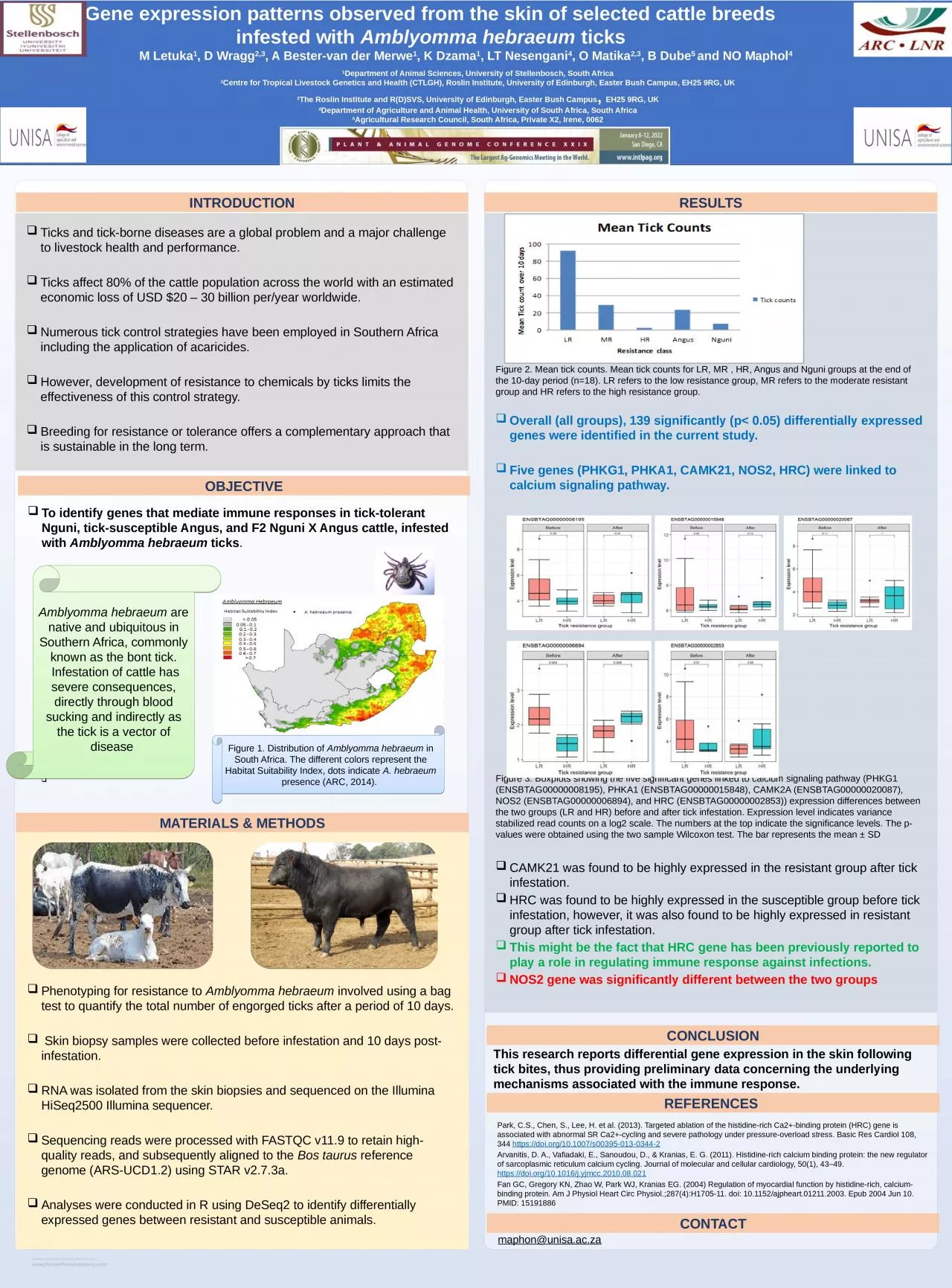

Amblyomma hebraeum ticks M Letuka 1 D Wragg 23 A Bestervan der Merwe 1 K Dzama 1 LT Nesengani 4 O Matika 23 B Dube 5 and NO Maphol 4 1 Department of Animal Sciences University of Stellenbosch South Africa ID: 933538
Download Presentation The PPT/PDF document "Gene expression patterns observed from t..." is the property of its rightful owner. Permission is granted to download and print the materials on this web site for personal, non-commercial use only, and to display it on your personal computer provided you do not modify the materials and that you retain all copyright notices contained in the materials. By downloading content from our website, you accept the terms of this agreement.
Slide1
Gene expression patterns observed from the skin of selected cattle breeds infested with Amblyomma hebraeum ticks
M Letuka1, D Wragg2,3, A Bester-van der Merwe1, K Dzama1, LT Nesengani4, O Matika2,3, B Dube5 and NO Maphol4
1Department of Animal Sciences, University of Stellenbosch, South Africa2Centre for Tropical Livestock Genetics and Health (CTLGH), Roslin Institute, University of Edinburgh, Easter Bush Campus, EH25 9RG, UK3The Roslin Institute and R(D)SVS, University of Edinburgh, Easter Bush Campus, EH25 9RG, UK4Department of Agriculture and Animal Health, University of South Africa, South Africa5Agricultural Research Council, South Africa, Private X2, Irene, 0062
INTRODUCTION
OBJECTIVE
MATERIALS & METHODS
RESULTS
CONCLUSION
REFERENCES
CONTACT
maphon@unisa.ac.za
Park, C.S., Chen, S., Lee, H. et al. (2013). Targeted ablation of the histidine-rich Ca2+-binding protein (HRC) gene is associated with abnormal SR Ca2+-cycling and severe pathology under pressure-overload stress. Basic Res Cardiol 108, 344 https://doi.org/10.1007/s00395-013-0344-2Arvanitis, D. A., Vafiadaki, E., Sanoudou, D., & Kranias, E. G. (2011). Histidine-rich calcium binding protein: the new regulator of sarcoplasmic reticulum calcium cycling. Journal of molecular and cellular cardiology, 50(1), 43–49. https://doi.org/10.1016/j.yjmcc.2010.08.021Fan GC, Gregory KN, Zhao W, Park WJ, Kranias EG. (2004) Regulation of myocardial function by histidine-rich, calcium-binding protein. Am J Physiol Heart Circ Physiol.;287(4):H1705-11. doi: 10.1152/ajpheart.01211.2003. Epub 2004 Jun 10. PMID: 15191886
This research reports differential gene expression in the skin following tick bites, thus providing preliminary data concerning the underlying mechanisms associated with the immune response.
Figure 2. Mean tick counts. Mean tick counts for LR, MR , HR, Angus and Nguni groups at the end of the 10-day period (n=18). LR refers to the low resistance group, MR refers to the moderate resistant group and HR refers to the high resistance group.Overall (all groups), 139 significantly (p< 0.05) differentially expressed genes were identified in the current study. Five genes (PHKG1, PHKA1, CAMK21, NOS2, HRC) were linked to calcium signaling pathway. Figure 3. Boxplots showing the five significant genes linked to calcium signaling pathway (PHKG1 (ENSBTAG00000008195), PHKA1 (ENSBTAG00000015848), CAMK2A (ENSBTAG00000020087), NOS2 (ENSBTAG00000006894), and HRC (ENSBTAG00000002853)) expression differences between the two groups (LR and HR) before and after tick infestation. Expression level indicates variance stabilized read counts on a log2 scale. The numbers at the top indicate the significance levels. The p-values were obtained using the two sample Wilcoxon test. The bar represents the mean ± SDCAMK21 was found to be highly expressed in the resistant group after tick infestation. HRC was found to be highly expressed in the susceptible group before tick infestation, however, it was also found to be highly expressed in resistant group after tick infestation. This might be the fact that HRC gene has been previously reported to play a role in regulating immune response against infections. NOS2 gene was significantly different between the two groups
Ticks and tick-borne diseases are a global problem and a major challenge to livestock health and performance. Ticks affect 80% of the cattle population across the world with an estimated economic loss of USD $20 – 30 billion per/year worldwide. Numerous tick control strategies have been employed in Southern Africa including the application of acaricides. However, development of resistance to chemicals by ticks limits the effectiveness of this control strategy. Breeding for resistance or tolerance offers a complementary approach that is sustainable in the long term.
To identify genes that mediate immune responses in tick-tolerant Nguni, tick-susceptible Angus, and F2 Nguni X Angus cattle, infested with Amblyomma hebraeum ticks.
Phenotyping for resistance to Amblyomma hebraeum involved using a bag test to quantify the total number of engorged ticks after a period of 10 days. Skin biopsy samples were collected before infestation and 10 days post-infestation. RNA was isolated from the skin biopsies and sequenced on the Illumina HiSeq2500 Illumina sequencer. Sequencing reads were processed with FASTQC v11.9 to retain high-quality reads, and subsequently aligned to the Bos taurus reference genome (ARS-UCD1.2) using STAR v2.7.3a. Analyses were conducted in R using DeSeq2 to identify differentially expressed genes between resistant and susceptible animals.
Amblyomma hebraeum are native and ubiquitous in Southern Africa, commonly known as the bont tick. Infestation of cattle has severe consequences, directly through blood sucking and indirectly as the tick is a vector of disease
Figure 1. Distribution of
Amblyomma hebraeum
in South Africa. The different colors represent the Habitat Suitability Index, dots indicate
A. hebraeum
presence (ARC, 2014).